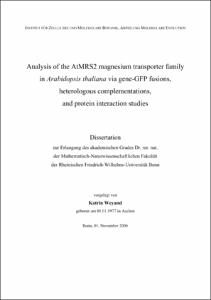Weyand, Katrin: Analysis of the AtMRS2 magnesium transporter family in Arabidopsis thaliana via gene-GFP fusions, heterologous complementations, and protein interaction studies. - Bonn, 2007. - Dissertation, Rheinische Friedrich-Wilhelms-Universität Bonn.
Online-Ausgabe in bonndoc: https://nbn-resolving.org/urn:nbn:de:hbz:5N-09472
Online-Ausgabe in bonndoc: https://nbn-resolving.org/urn:nbn:de:hbz:5N-09472
@phdthesis{handle:20.500.11811/3044,
urn: https://nbn-resolving.org/urn:nbn:de:hbz:5N-09472,
author = {{Katrin Weyand}},
title = {Analysis of the AtMRS2 magnesium transporter family in Arabidopsis thaliana via gene-GFP fusions, heterologous complementations, and protein interaction studies},
school = {Rheinische Friedrich-Wilhelms-Universität Bonn},
year = 2007,
note = {Magnesium is unique in its chemical properties compared to the other biologically relevant cations. It plays an important role in many biological functions, e.g. as a cofactor for numerous enzymes, as the central atom of the chlorophyll, and as a regulator of key photosynthetic enzymes. The magnesium transport proteins described so far correlate with the unique physicochemical properties of the Mg2+ cation: they form new classes of transport proteins, mostly with no homology to known ion transporters. One class of magnesium transport proteins found in every domain of life are the 2-TM-GxN proteins belonging to the metal ion transporter superfamily. Members of this superfamily are the well-characterised CorA protein of prokaryotes and the yeast ALR1/2 and MRS2/LPE10 proteins. Our group has described the extended MRS2 gene family in the model plant Arabidopsis thaliana, comprised of eleven core members and four distantly related members.
Analysis of the members of the AtMRS2 gene family in this thesis was focused both on localization and functional studies. The question of subcellular localization was addressed via cotranslational fusions of the AtMRS2 proteins to the N-terminus of the green fluorescent protein, GFP. Multiple approaches with full length and C-terminally shortened AtMRS2-GFP constructs were conducted, both stably expressed in Arabidopsis and transiently expressed in tobacco leaf sections and protoplasts, using two different vector backbones. No positive, convincing results could be obtained, though. Obviously, gene-GFP fusions seem not to be the best suited tool for determination of the subcellular localization of the AtMRS2 proteins; different approaches should be considered in the future.
Characterisation of three members of the AtMRS2 family in the Δmrs2 mutant yeast strain could prove their functionality as magnesium transporters; the transport capacities were measured using the mag-fura 2 system in combination with isolated yeast mitochondria. A second approach to determine the properties of three further magnesium transporters through expression in Xenopus oocytes and electrophysiological measurements gave no results; Xenopus oocytes seem not to be suited for the functional characterisation of the AtMRS2 proteins.
First hints on the oligomerisation properties of the AtMRS2 proteins, which form a pentamer as the functional transporter, could be gained from protein interaction studies in the mating-based split ubiquitin system in yeast. The results obtained so far for a limited number of AtMRS2 proteins indicate that the AtMRS2 proteins can form both homo- and heterooligomers; heterooligomerisation, though, seems to be restricted to certain protein pairings.},
url = {https://hdl.handle.net/20.500.11811/3044}
}
urn: https://nbn-resolving.org/urn:nbn:de:hbz:5N-09472,
author = {{Katrin Weyand}},
title = {Analysis of the AtMRS2 magnesium transporter family in Arabidopsis thaliana via gene-GFP fusions, heterologous complementations, and protein interaction studies},
school = {Rheinische Friedrich-Wilhelms-Universität Bonn},
year = 2007,
note = {Magnesium is unique in its chemical properties compared to the other biologically relevant cations. It plays an important role in many biological functions, e.g. as a cofactor for numerous enzymes, as the central atom of the chlorophyll, and as a regulator of key photosynthetic enzymes. The magnesium transport proteins described so far correlate with the unique physicochemical properties of the Mg2+ cation: they form new classes of transport proteins, mostly with no homology to known ion transporters. One class of magnesium transport proteins found in every domain of life are the 2-TM-GxN proteins belonging to the metal ion transporter superfamily. Members of this superfamily are the well-characterised CorA protein of prokaryotes and the yeast ALR1/2 and MRS2/LPE10 proteins. Our group has described the extended MRS2 gene family in the model plant Arabidopsis thaliana, comprised of eleven core members and four distantly related members.
Analysis of the members of the AtMRS2 gene family in this thesis was focused both on localization and functional studies. The question of subcellular localization was addressed via cotranslational fusions of the AtMRS2 proteins to the N-terminus of the green fluorescent protein, GFP. Multiple approaches with full length and C-terminally shortened AtMRS2-GFP constructs were conducted, both stably expressed in Arabidopsis and transiently expressed in tobacco leaf sections and protoplasts, using two different vector backbones. No positive, convincing results could be obtained, though. Obviously, gene-GFP fusions seem not to be the best suited tool for determination of the subcellular localization of the AtMRS2 proteins; different approaches should be considered in the future.
Characterisation of three members of the AtMRS2 family in the Δmrs2 mutant yeast strain could prove their functionality as magnesium transporters; the transport capacities were measured using the mag-fura 2 system in combination with isolated yeast mitochondria. A second approach to determine the properties of three further magnesium transporters through expression in Xenopus oocytes and electrophysiological measurements gave no results; Xenopus oocytes seem not to be suited for the functional characterisation of the AtMRS2 proteins.
First hints on the oligomerisation properties of the AtMRS2 proteins, which form a pentamer as the functional transporter, could be gained from protein interaction studies in the mating-based split ubiquitin system in yeast. The results obtained so far for a limited number of AtMRS2 proteins indicate that the AtMRS2 proteins can form both homo- and heterooligomers; heterooligomerisation, though, seems to be restricted to certain protein pairings.},
url = {https://hdl.handle.net/20.500.11811/3044}
}






